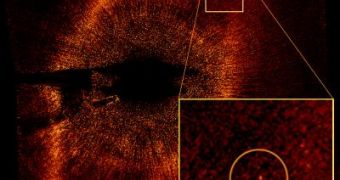During a period a bit over a dozen years, planet hunters have come upon over 300 exoplanets, but they have done so by calculating light, speed or gravity changes of the stars they were thought to orbit. This time, two astronomer teams have managed to spot exoplanets directly, by means of actual photographs. Astronomer Paul Kalas' group used a photo taken by Hubble, while the other, led by Bruce Macintosh from the Lawrence Livermore National Laboratory, obtained their image using ground telescopes.
Kalas had been monitoring the star Formalhaut (“Mouth of the Fish” in Arabic), situated 25 light years away, in the Piscis Austrinus constellation, for more than 3 years now, when he observed that the gaseous ring surrounding it was perturbed by an unseen object. The image taken of the planet suggests that it is located very close in astronomic terms to Earth (at a distance of 148 trillion miles, or 238 trillion kilometers), being among the smallest exoplanets ever found. Its size is not yet determined, but it's supposed to be between Neptune's and 4 times that of Jupiter.
Formalhaut b, as it was labeled, is a young planet (about 200 million years old, while those in our solar system are more than 4 billion years of age) that sports a temperature of about 260 degrees, which is relatively low compared with other exoplanets. Comparisons could indicate the way our solar system's planets might have looked like in their youth, with differences taken into account. The image also shows that Formalhaut b might feature a ring system like that of Jupiter before it gave “birth” to the 4 moons.
The image is not very clear because the star Formalhaut is brighter than the planet by a factor of about 100 million. Kalas has explained that the two pictures that he has of the planet (one from 2004 and the other from 2006) indicate exactly the expected motion over 21 months of a planet moving around that star in an 872-year cycle, from a distance of 11 billion miles (17.7 billion kilometers). "I nearly had a heart attack at the end of May when I confirmed that Fomalhaut b orbits its parent star," shared Kalas, quoted by Reuters. "It's a profound and overwhelming experience to lay eyes on a planet never before seen."

 14 DAY TRIAL //
14 DAY TRIAL //